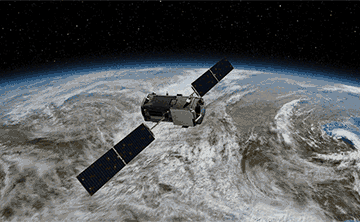It was 2 a.m. on February 24, 2009, and six years of George Mount’s work had just launched toward space.
Mount, then a physicist in the WSU Department of Civil and Environmental Engineering, had been part of a team led by NASA’s Jet Propulsion Laboratory to develop the Orbiting Carbon Observatory (OCO), a sophisticated instrument to measure carbon dioxide from space.
It looked like a picture-perfect launch. The researchers had boarded buses from the launch site and were riding back to their hotel when they learned the news: The rocket carrying their satellite had failed to reach orbit. Instead, the rocket and its payload burned up as it fell back to earth in pieces, landing in the ocean near Antarctica.
Five years later, Mount recalls the moment. But he wasn’t discouraged for long. Even after retirement in 2012, he stayed involved with the project, which relaunched successfully on July 2, 2014.
Nowadays, more than a decade after starting work on the OCO, Mount sets his own schedule, takes vacations, and avoids faculty meetings. Still, the emeritus professor is drawn to continue the work that he loves.
He seems to have endless energy when it comes to creating spectrometers or the science of measuring missing carbon dioxide in the atmosphere and its relation to climate change, all reasons he threw his efforts into helping rebuild the OCO project. “Everyone’s excited about the new instrument. It’s going to be great,’’ he says. “The science is still there to be done.’’
Currently, high precision carbon dioxide measurements are made from the ground at only a handful of locations around the world. The measurements are important because increasing levels of carbon dioxide in the atmosphere from human emissions of fossil fuels are contributing to global warming. Scientists have an excellent understanding of the levels of global carbon emissions, which total about eight gigatons per year. But only half of the carbon dioxide that is emitted stays in the atmosphere. The rest is taken up by oceans or biomass, and nobody understands exactly where it is going and why the amount that stays in the atmosphere varies dramatically year to year.
The orbiting observatory will use three infrared grating spectrometers to measure carbon dioxide levels throughout the global atmosphere. It will be like a pencil that draws a line around the world. While the earth rotates under it, the OCO will precisely measure the carbon dioxide column in its 10-kilometer-wide pencil line. The cycle will repeat every 16 days.
In 2003 Mount joined a review board for the project. The board oversees everything from plans and schedules to instrument construction, testing, calibration, and software. Mount’s contribution was in the science for the satellite as well as the instrument’s optical design and testing.
The first instrument that the Jet Propulsion Laboratory built, recalls Mount, was a beauty— although there were plenty of challenges. “I spent quite a bit of time in the trenches once the instrument was ready for characterization in the thermal/vacuum environment’’ he says. “It was a wonderful experience.’’
To calibrate it, the researchers made careful measurements with the instrument cold and in a vacuum, as it would be in space. They also took geophysical measurements of the atmosphere from the vacuum chamber, and compared them with results from a high resolution, ground-based system. It’s important to do geophysical measurements of the real atmosphere, so the researchers took measurements of carbon dioxide levels in Los Angeles. At JPL, the researchers cut a hole in the roof—just so their instrument in its vacuum chamber could see the sun and measure the atmospheric CO2 content between the roof and the sun.
“The OCO measurement system worked out even better than we all had hoped,’’ says Mount.
Five years later, the project was ready to be sent into orbit and put to work. But the launch failed. Within a few months, JPL researchers submitted a proposal to rebuild the instrument. The project would cost less because the engineering had already been done, and the researchers had quite a few spare parts from the previous effort.
Even though they were rebuilding an instrument, the process was still meticulous and lengthy. After receiving funding in 2010, NASA needed two years to complete the construction and characterization. The instrument itself then had to be installed in a satellite ‘bus,’ which holds the satellite navigation instrumentation, power sources, and radio equipment. Integration testing and replacement of a failed major part of the bus system occurred in 2012 and 2013, with final testing in late 2013 and into 2014. Last May, the instrument, now sitting cozily in its bus, was shipped to Vandenburg Air Force base in California, for final tests and installation on top of a Boeing Delta II rocket ready to be launched in early July.
Relishing the success of the second, successful, launch effort, Mount is looking forward to even more science. He’s still getting data daily from a Dutch space-based instrument launched in 2004 aboard a NASA satellite that globally measures atmospheric trace gases. There are also ongoing grants and a commitment to JPL until 2017 to continue with OCO projects, including scanning of targeted urban areas.


